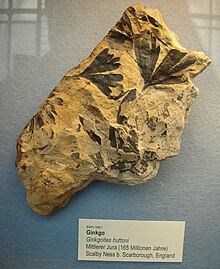Ginkgoites
Appearance
| Ginkgoites | |
|---|---|

| |
| fossil leaves identified as Gingkoites | |
| Scientific classification | |
| Kingdom: | Plantae |
| Clade: | Tracheophytes |
| Clade: | Gymnospermae |
| Division: | Ginkgophyta |
| Class: | Ginkgoopsida |
| Order: | Ginkgoales |
| Family: | Ginkgoaceae |
| Genus: | †Ginkgoites |
| Species | |
| |
Ginkgoites is a genus that refers to extinct plants belonging to Ginkgoaceae. Fossils of these plants have been found around the globe during the Triassic, Jurassic and Cretaceous. The name was created as a form genus in 1919 by Albert Seward who stated: "I ... propose to employ the name Ginkgoites for leaves that it is believed belong either to plants generically identical with Ginkgo or to very closely allied types".[1]
Distribution
- In Paleorrota geopark in Brazil. Upper Triassic period, the Santa Maria Formation.[2]
References
- ^ Albert Charles Seward (1919), Fossil plants: for students of botany and geology, vol. 4, Cambridge University Press, p. 10, doi:10.5962/bhl.title.54901
- ^ Passo das Tropas, Santa Maria, RS. Marco bioestratigráfico triássico na evolução paleoflorística do Gondwana na Bacia do Paraná
Categories:
- Ginkgophyta
- Prehistoric plant genera
- Cretaceous plants
- Jurassic plants
- Triassic plants
- Norian first appearances
- Campanian genus extinctions
- Prehistoric plants of South America
- Permian life of South America
- Triassic life of South America
- Permian Brazil
- Triassic Brazil
- Flora of Rio Grande do Sul
- Fossils of Brazil
- Santa Maria Formation
- Fossil taxa described in 1919
